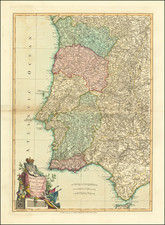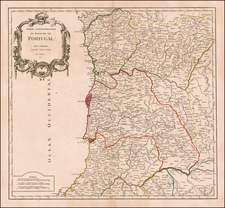Previously unrecorded 1780 edition of this rare and highly detailed map of the Iberian Peninsula and the Balearic Islands, created by Jean-Baptiste Crepy. This map is considered a valuable historical artifact, largely unrecorded in existing records, showcasing the intricate political divisions and rich cultural heritage of the region during the 18th century.
The political history of Spain in the 18th century was marked by significant changes and conflicts. At the time, Spain was divided into two primary divisions: the Kingdom of Aragon (Reyno de Aragón) and the Kingdom of Castile (Reyno de Castilla). These divisions were further subdivided into numerous provinces, each with its distinct characteristics and cultural identities. The map displays these subdivisions in great detail, offering a comprehensive view of the administrative divisions within the two primary states.
The cartouche on the map is particularly elaborate and visually captivating. It is surmounted by 14 coats of arms, each representing a specific province or territory. The coat of arms of Portugal is one of the 14, as the map encompasses the entire Iberian Peninsula, including Portugal, which was a separate kingdom.
An intriguing aspect of this map is that it was published with both Spanish and French titles. This duality in titles reflects the beginning of the opening of Spanish markets and the influence of the French Enlightenment during that period. The Spanish Enlightenment, also known as the "Siglo de las Luces" (Age of Enlightenment), was a time of intellectual and cultural transformation in Spain. It was characterized by a growing interest in science, reason, and progress. The publication of the map with French titles suggests an increasing exchange of ideas and knowledge between Spain and other European countries, particularly France, during this enlightening period.
Overall, Jean-Baptiste Crepy's map of the Iberian Peninsula provides a fascinating glimpse into the political divisions, regional identities, and cultural richness of Spain in the 18th century. Its detailed representation of provinces, incorporation of coats of arms, and the presence of both Spanish and French titles contribute to its historical significance, reflecting the shifting political landscape and the increasing intellectual exchange that marked the beginning of the Spanish Enlightenment.
While we were able to locate later maps of a similar title by Nolin and Mondhare, we have not located any examples of Crepy's map.









![Islands in the Atlantic [Bermuda, Madeira, Canaries, Azores and Cape Verde Islands]](https://storage.googleapis.com/raremaps/img/small/48868.jpg)

![[Catalan Portolan Sea Chart] Descripcion de la Costa de España Portugal y Parte de la Barbaria contiene la sonda con la calidad de Fondo segun se a Podida y moestiear Advartencia . . . Sacado de su original en la Havana 1776](https://storage.googleapis.com/raremaps/img/small/50534.jpg)
![[Penisola Castle / Valencian/Catalan Coast] Coste d'Espagne depuis Peniscola Jusqu'au Hamau du Canard ou Alcanario (hand drawn map)](https://storage.googleapis.com/raremaps/img/small/91695.jpg)

